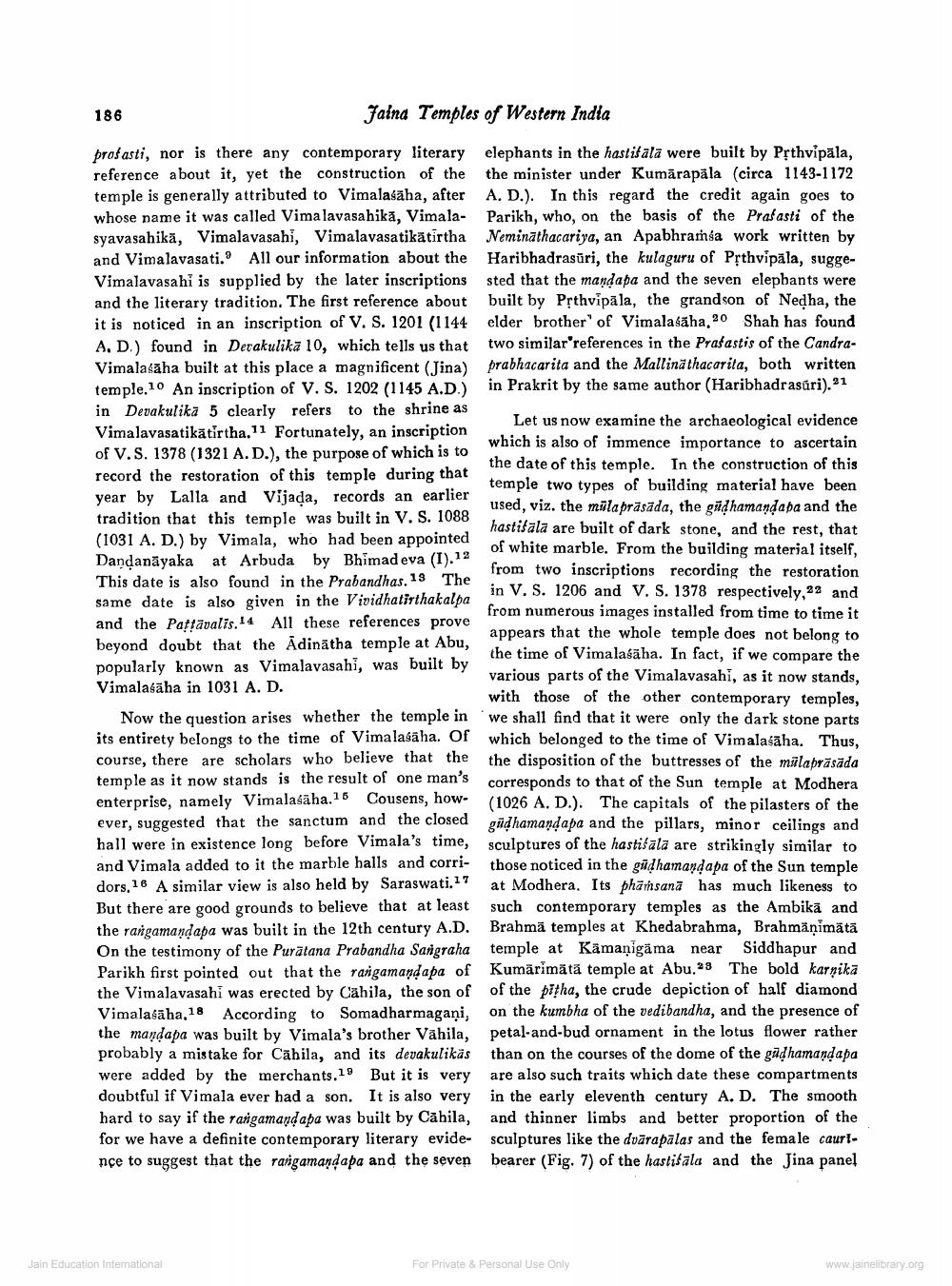________________
186
Jalna Temples of Western India
prošasti, nor is there any contemporary literary elephants in the hastišala were built by Pộthvipāla, reference about it, yet the construction of the the minister under Kumārapāla (circa 1143-1172 temple is generally attributed to Vimalasāha, after A. D.). In this regard the credit again goes to whose name it was called Vimalavasahikā, Vimala- Parikh, who, on the basis of the Prasasti of the syavasahikā, Vimalavasahi, Vimalavasatikātirtha Nemināthacariya, an Apabhramsa work written by and Vimalavasati.' All our information about the Haribhadrasūri, the kulaguru of Pșthvipāla, suggeVimalavasahi is supplied by the later inscriptions sted that the mandaba and the seven elephants were and the literary tradition. The first reference about built by Prthvipāla, the grandson of Nedha, the it is noticed in an inscription of V. S. 1201 (1144 elder brother of Vimalasāha,20 Shah has found A, D.) found in Derakulika 10, which tells us that two similar references in the Prašastis of the CandraVimalatha built at this place a magnificent (Tina) prabhacarita and the Mallina thacarita, both written temple.10 An inscription of V. S. 1202 (1145 A.D.) in Prakrit by the same author (Haribhadrasuri).21 in Devakulika 5 clearly refers to the shrine as
Let us now examine the archaeological evidence Vimalavasatikātirtha.11 Fortunately, an inscription
which is also of immence importance to ascertain of V.S. 1378 (1321 A.D.), the purpose of which is to
the date of this temple. In the construction of this record the restoration of this temple during that
temple two types of building material have been year by Lalla and Vijada, records an earlier
used, viz. the mülaprāsāda, the gūdhamandaba and the tradition that this temple was built in V. S. 1088
hastišala are built of dark stone, and the rest, that (1031 A. D.) by Vimala, who had been appointed
of white marble. From the building material itself, Dandanayaka at Arbuda by Bhimad eva (1).12
from This date is also found in the Prabandhas. 19
two inscriptions recording the restoration The
in V. S. 1206 and V. S. 1378 respectively, 22 and same date is also given in the Vividhatirthakalpa
from numerous images installed from time to time it and the Paffävalis. 14 All these references prove
appears that the whole temple does not belong to beyond doubt that the Ādinātha temple at Abu,
the time of Vimalasäha. In fact, if we compare the popularly known as Vimalayasahi, was built by
various parts of the Vimalavasahi, as it now stands, Vimalasāha in 1031 A. D.
with those of the other contemporary temples, Now the question arises whether the temple in we shall find that it were only the dark stone parts its entirety belongs to the time of Vimalasaha. Of which belonged to the time of Vimalasaha. Thus, course, there are scholars who believe that the the disposition of the buttresses of the mūlabrāsāda temple as it now stands is the result of one man's corresponds to that of the Sun temple at Modhera enterprise, namely Vimalasäha.16 Cousens, how- (1026 A. D.). The capitals of the pilasters of the ever, suggested that the sanctum and the closed güdhamandapa and the pillars, minor ceilings and hall were in existence long before Vimala's time, sculptures of the hastifāla are strikingly similar to and Vimala added to it the marble halls and corri- those noticed in the gūdhamandapa of the Sun temple dors. 16 A similar view is also held by Saraswati."" at Modhera. Its pharsana has much likeness to But there are good grounds to believe that at least such contemporary temples as the Ambikā and the rangamandapa was built in the 12th century A.D. Brahmä temples at Khedabrahma, Brahmänimātā On the testimony of the Purātana Prabandha Sangraha temple at Kämanigama near Siddhapur and Parikh first pointed out that the rangamandapa of Kumārimātā temple at Abu.29 The bold karnika the Vimalavasahi was erected by Cahila, the son of of the pitha, the crude depiction of half diamond Vimalasāha.18 According to Somadharmagani, on the kumbha of the vedibandha, and the presence of the mandapa was built by Vimala's brother Vahila, petal-and-bud ornament in the lotus flower rather probably a mistake for Cahila, and its devakulikäs than on the courses of the dome of the gadhamandapa were added by the merchants.18 But it is very are also such traits which date these compartments doubtful if Vimala ever had a son. It is also very in the early eleventh century A. D. The smooth hard to say if the rangamand apa was built by Căbila, and thinner limbs and better proportion of the for we have a definite contemporary literary evide- sculptures like the dvārapālas and the female cauri. nce to suggest that the rangamandapa and the seven bearer (Fig. 7) of the hastifāla and the Jina panel
Jain Education International
For Private & Personal use only
www.jainelibrary.org




